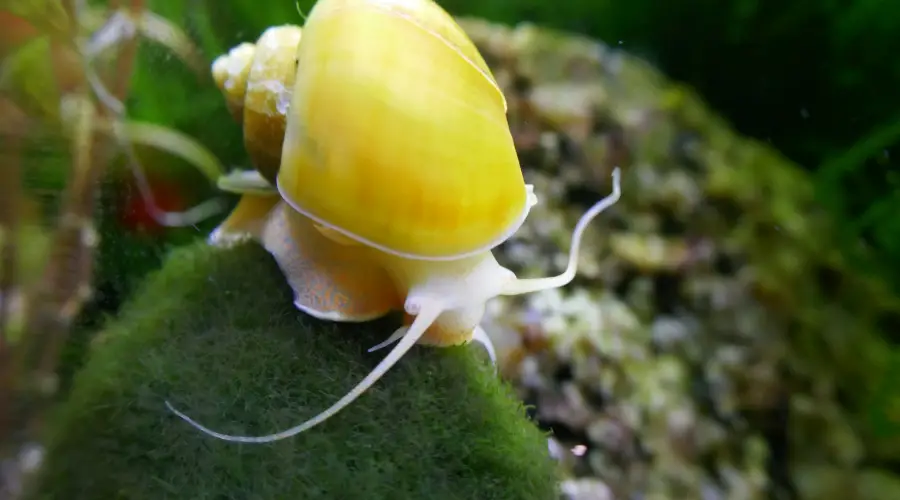- Mystery snails are known to grow to a diameter of 2 inches
- This snail species do well in 5 to 10-gallon water tanks
- The Females will typically lay their eggs above the waterline
Did you know that mystery snails are among some of the larger snail species? They are known to grow to the size of a golf ball.
These beautiful snails reproduce ‘mysteriously’, fully developed snails ‘suddenly’ and appear hence the name ‘Mystery Snail’ [1]
How big do Mystery snails get?
On average they are known to grow to a diameter of 2 inches. [2] There size varies with different types as outlined below:
- Golden mystery snails will grow to a shell diameter of 1 to 3 inches
- The Chinese mystery snail grows up to 1.5 inches as an adult
- Black mystery snails become very large as adults growing up to 3 inches in diameter
- Ivory mystery snails are usually 1 to 2 inches in diameter when purchased but can grow up to 3 inches in diameter with the right water conditions
- Blue mystery snails are known to grow to a size of 2 to 3 inches in diameter as adults
- Purple mystery snails are also known to grow up to 3 inches in diameter as adults
Hatchling mystery snails have a length of around 1 inch at birth. Their growth and consequently final size as an adult depends on the quality of the food and water environment in which they live.
To grow mystery snails to a big size, they should be fed a healthy diet that includes algae and healthy green vegetables two to three times a week as well as calcium-rich foods.
What size of tank do they need?
Although mystery snails can do well in almost all-size tanks, it is best to keep them in 5 to 10-gallon tanks.
They also do well in larger tanks with a more established aquarium community.
As for the snail ratio, it’s recommended to keep 1 to 2 snails in every 5 gallons. This will provide enough space for them to move around and have enough to feed on.
Mystery snails will usually require an environment full of vegetation. This kind of environment provides plenty of natural food for mystery snails whose main diet is decaying plant matter.
They are best adapted for high oxygenated waters and as such vegetation in tanks will provide high oxygen levels. For this reason, mystery snails will fit best in tropical community tanks which are not only functional but highly aesthetic.
Some plants to consider introducing in aquariums include the hornwort and java fern which are very hardy.
Aquariums housing mystery snails should have tight-fitting lids to ensure they don’t escape as they are known to swim out of water especially if food sources are inadequate.
Can Mystery snails live with other snails?
When it comes to tank mates, fish such as guppies and killifish are recommended as they can peacefully cohabit. Preferred invertebrates include cherry, ghost, and Amano shrimp which are peaceful invertebrates.
Mystery snails can also coexist with other snail species such as Ramshorn Nerite and Ivory snails. They will however be prey to specific predators such as Oscars, cichlids, and clown loaches.
These snails are very sensitive to water quality. In the case the water quality begins to deteriorate, mystery snails would typically begin moving to the surface.
Water quality should therefore strictly be tropical-like, with a temperature of 20°C—28°C., a pH: 6.5—7.5, and a general Hardness of about 150—300 ppm.
How do Mystery snails reproduce?
Mystery snails are viviparous meaning they bring out live ones from the body of the parent, and gonochoric meaning they have both males and females in their species, unlike other hermaphrodite species. [2]
When do they breed?
A mystery snail is usually considered ready to breed once it’s around the size of a golf ball, which can be anywhere from two months provided it has the right diet.
To increase the chances of breeding, aquarists should lower the water level by a few inches to create room for the female to lay eggs.
Once the embryos reach a juvenile state they will usually be released from the uterus. The female snails will typically lay their eggs just above the water line in hard-shelled clusters which will usually be pink or white.
When do the eggs hatch?
The hatching period for mystery snails will typically be 2 to 4 weeks and depends on factors such as temperature and humidity levels.
Female snails are reported to be able to produce more than 169 embryos in their lifetime though there have been cases of mystery snails carrying more than 102 embryos in one reproductive cycle!
After hatching, the hatchling mystery snail will fall back into the water.
Too many hatchlings could also impact the nitrogen cycle therefore, it is necessary to control the number of hatchlings.
Snails can be at risk of falling prey after hatching especially if they share an aquarium with other tropical fish.
Mystery snails are moderately amphibious meaning it can breathe out of water for some time. Additionally, they also have an operculum that is closed once the snail leaves water enabling them to survive out of water for some time without drying.
If you love to watch snails hatch, here is an interesting video I came across!
Next read:


